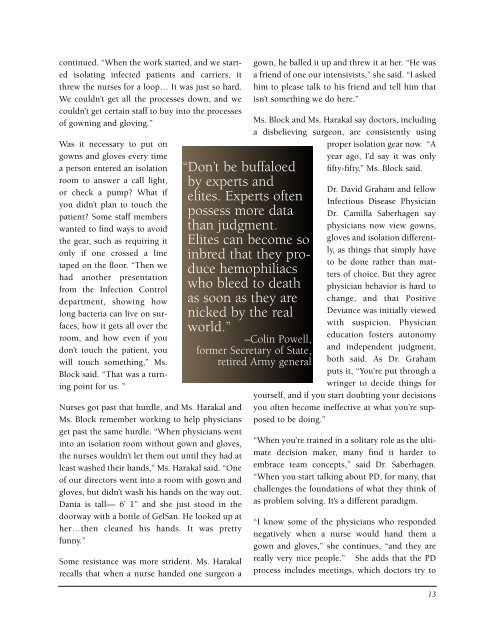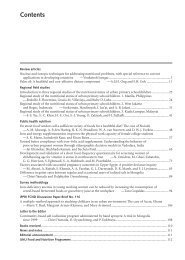From Invisible to Visible - Positive Deviance Initiative
From Invisible to Visible - Positive Deviance Initiative
From Invisible to Visible - Positive Deviance Initiative
Create successful ePaper yourself
Turn your PDF publications into a flip-book with our unique Google optimized e-Paper software.
continued. “When the work started, and we started<br />
isolating infected patients and carriers, it<br />
threw the nurses for a loop… It was just so hard.<br />
We couldn’t get all the processes down, and we<br />
couldn’t get certain staff <strong>to</strong> buy in<strong>to</strong> the processes<br />
of gowning and gloving.”<br />
Was it necessary <strong>to</strong> put on<br />
gowns and gloves every time<br />
a person entered an isolation<br />
room <strong>to</strong> answer a call light,<br />
or check a pump? What if<br />
you didn’t plan <strong>to</strong> <strong>to</strong>uch the<br />
patient? Some staff members<br />
wanted <strong>to</strong> find ways <strong>to</strong> avoid<br />
the gear, such as requiring it<br />
only if one crossed a line<br />
taped on the floor. “Then we<br />
had another presentation<br />
from the Infection Control<br />
department, showing how<br />
long bacteria can live on surfaces,<br />
how it gets all over the<br />
room, and how even if you<br />
don’t <strong>to</strong>uch the patient, you<br />
will <strong>to</strong>uch something,” Ms.<br />
Block said. “That was a turning<br />
point for us. ”<br />
Nurses got past that hurdle, and Ms. Harakal and<br />
Ms. Block remember working <strong>to</strong> help physicians<br />
get past the same hurdle. “When physicians went<br />
in<strong>to</strong> an isolation room without gown and gloves,<br />
the nurses wouldn’t let them out until they had at<br />
least washed their hands,” Ms. Harakal said. “One<br />
of our direc<strong>to</strong>rs went in<strong>to</strong> a room with gown and<br />
gloves, but didn’t wash his hands on the way out.<br />
Dania is tall— 6’ 1” and she just s<strong>to</strong>od in the<br />
doorway with a bottle of GelSan. He looked up at<br />
her…then cleaned his hands. It was pretty<br />
funny.”<br />
Some resistance was more strident. Ms. Harakal<br />
recalls that when a nurse handed one surgeon a<br />
“Don’t be buffaloed<br />
by experts and<br />
elites. Experts often<br />
possess more data<br />
than judgment.<br />
Elites can become so<br />
inbred that they produce<br />
hemophiliacs<br />
who bleed <strong>to</strong> death<br />
as soon as they are<br />
nicked by the real<br />
world.”<br />
–Colin Powell,<br />
former Secretary of State,<br />
retired Army general<br />
gown, he balled it up and threw it at her. “He was<br />
a friend of one our intensivists,” she said. “I asked<br />
him <strong>to</strong> please talk <strong>to</strong> his friend and tell him that<br />
isn’t something we do here.”<br />
Ms. Block and Ms. Harakal say doc<strong>to</strong>rs, including<br />
a disbelieving surgeon, are consistently using<br />
proper isolation gear now. “A<br />
year ago, I’d say it was only<br />
fifty-fifty,” Ms. Block said.<br />
Dr. David Graham and fellow<br />
Infectious Disease Physician<br />
Dr. Camilla Saberhagen say<br />
physicians now view gowns,<br />
gloves and isolation differently,<br />
as things that simply have<br />
<strong>to</strong> be done rather than matters<br />
of choice. But they agree<br />
physician behavior is hard <strong>to</strong><br />
change, and that <strong>Positive</strong><br />
<strong>Deviance</strong> was initially viewed<br />
with suspicion. Physician<br />
education fosters au<strong>to</strong>nomy<br />
and independent judgment,<br />
both said. As Dr. Graham<br />
puts it, “You’re put through a<br />
wringer <strong>to</strong> decide things for<br />
yourself, and if you start doubting your decisions<br />
you often become ineffective at what you’re supposed<br />
<strong>to</strong> be doing.”<br />
“When you’re trained in a solitary role as the ultimate<br />
decision maker, many find it harder <strong>to</strong><br />
embrace team concepts,” said Dr. Saberhagen.<br />
“When you start talking about PD, for many, that<br />
challenges the foundations of what they think of<br />
as problem solving. It’s a different paradigm.<br />
“I know some of the physicians who responded<br />
negatively when a nurse would hand them a<br />
gown and gloves,” she continues, “and they are<br />
really very nice people.” She adds that the PD<br />
process includes meetings, which doc<strong>to</strong>rs try <strong>to</strong><br />
13

















